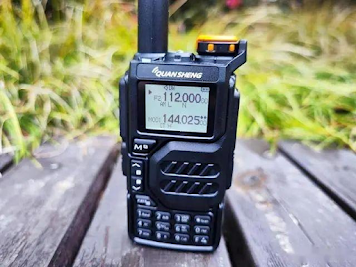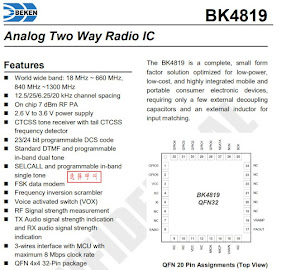Interesting new Chinese radio that has the Beken RF BK4819 chip which allows for a wider frequency range and custom firmware (see quoted post below). Note, this radio doesn’t put out much power on these other bands and lacks proper filtering (see second video for harmonics), so I wouldn’t use it outside the 2m and 70cm bands. But it does look like an interesting radio to play with, and a very interesting radio for amateur radio use. And usually these firmware projects expand and really add a lot of functionality over the stock firmware. Consequently, It doesn’t look like it’s certified for LMR or GMRS use, but just Amateur Radio use per https://fcc.report/FCC-ID/XBPUV-K5 (but checked on all radio bands to not put out interference so you could probably get away with using it on GMRS).
https://quansheng-radio.blogspot.com/2023/06/exploring-experimental-firmware-for.html
The Quansheng UV K5 radio has recently gained attention due to reports of its firmware being hacked.
The UV K5 is a recent multiband radio from China that stands out from the typical offerings in its category due to its superior quality and performance. Designed with advanced features and a sleek design, this radio caters to the needs of radio enthusiasts, hobbyists, and professionals alike. Chinese manufacturers have made significant strides in improving the overall quality of their products, and the UV K5 is a prime example of this progress. With intuitive controls although the naming is a bit cryptic, and a nice crisp display, this radio delivers an enhanced user experience over your typical chinese HT. Another remarkable aspect of the UV K5 is its affordability. Priced under $50, this radio offers an excellent value proposition.
This unofficial modification allows users to access a significantly wider range of frequencies. In this article, we will delve into this experimental firmware, its potential capabilities, and the necessary precautions users should take. Please note that this article is purely for informational purposes, and any actions taken with the radio are solely the responsibility of the users.

The UV K5 radio is based on the RF BK4819 chip manufactured by Beken. The BK4819 frequency range allow operation at 18-660 MHz and 840-1300 MHz, which is much broader than what UV-K5 the stock firmware allowed. However, with a patched firmware, it becomes possible to access the entire available frequency range, expanding the radio’s capabilities significantly.

Downloading the Original Firmware:
To begin, users interested in exploring the modified firmware need to visit the Quansheng website. In the website where you can access the firmware files. Once downloaded, extract the files to reveal a folder containing various files, including the firmware itself (in .bin format) provided by Quan Chang for regular updates.
Flashing the Firmware:
To load the original or modified firmware onto the radio, you will require the Baofeng USB programming (serial TTL) cable with a standard Kenwood plug.
The programming cable for the UV K5 can be obtained in two ways: either by purchasing factory made at a low price or by creating one yourself using the provided headset wiring and a USB-TTL converter.
If you’re a DIY enthusiast or prefer a more cost-effective solution, you have the option to create your own programming cable. By utilizing the headset wiring provided with the UV K5 and combining it with a USB-TTL converter, you can assemble a functional programming cable without breaking the bank. This DIY approach allows for customization and flexibility while keeping costs low.

Whether you choose to purchase the programming cable or embark on a DIY project, having a programming cable for the UV K5 opens up a world of possibilities for customization and optimization. Update your radio firmware, set memory channels, tailor settings to your preferences, and unlock the full potential of the UV K5 with the convenience and affordability of the programming cable option that suits you best.
Connect the cable to the radio, specifically to the port where the microphone and speaker jacks are located. Once connected, launch the portable radio tools program, which should already be installed on your device. Within the program, click on the “Connect” button to establish a connection with the radio.

Exploring the Modified Firmware:
A GitHub user named tunis1337 has developed modded firmware for the UV K5 radio, offering various modifications and additional features. These modified firmware versions expand the frequency range and enhance reception capabilities. Some firmware versions include regular FM reception from 18 MHz to 850 MHz or 1300 MHz, along with extended modulation capabilities.

Testing the Modified Firmware:
For testing purposes, let’s start by loading the firmware that covers the 18 MHz to 850 MHz range. Once the firmware is downloaded, load it into the radio using the program and click on the “Update” button. During this process, it is essential to follow the specific instructions provided in the firmware’s documentation. After successful installation, the radio will reboot, and you can begin testing.
Precautions and Legal Considerations:
While experimenting with the modified firmware, it is crucial to adhere to legal regulations and avoid transmitting on unauthorized frequencies. Only operate within the bands you are licensed or allowed to use. If you wish to test the output power, it is recommended to use a dummy load or a test set. Be aware of the hardware limitations, such as the BK4819 inability to receive signals between 630 MHz and 840 MHz.
Exploring Extended Frequencies:
For advanced users, there is an extended firmware version that allows reception in the 18 MHz to 1300 MHz range. This firmware introduces additional features and expands the radio’s capabilities further. By installing this firmware, you can potentially listen to various frequencies, including public safety trunk frequencies and even signals in the 1.2 GHz range. However, note that the radio does not support trunking, requiring manual frequency adjustments as the channels trunk.
Here is an updated list of users and their respective communication purposes within the approximate frequency ranges of 18-660 & 840-1300 MHz:
Amateur Radio Operators: Amateur radio operators, also known as hams, utilize frequencies ranging from 18-54 MHz (HF band) and 144-148 MHz, and 430-450 MHz (VHF/UHF bands), 1200 Mhz for personal communication, experimentation, and emergency communications.
Air Band: Air traffic control (ATC 118-136 Mhz) services, pilots, and aircraft operators communicate on frequencies within the airband range for flight coordination, navigation, and safety purposes. One interesting thing about this band is that it uses AM modulation, which is supported by the UV K5.
Citizens Band (CB) Radio: CB radios primarily operate around 27 MHz, which falls within the approximate range of 26.965-27.405 MHz. CB radio users employ these frequencies for short-range communication, such as truckers on highways or hobbyists communicating locally.
Marine Band: The marine band, also known as the maritime band, is a range of frequencies reserved for communications in the marine environment. This band is used by vessels, including recreational boats, commercial ships, and emergency services at sea. The UV K5 supports the FM modulation used in the marine band, allowing users to communicate effectively in this environment. Interesting channels in the marine band:
Channel 16: 156.800 MHz (Emergency and distress calling)
Channel 9: 156.450 MHz (Ship-to-ship calling and communication)
Channels 1 to 8: 156.050 MHz to 156.400 MHz (General communication and port operations)
Channels 68, 69, and 71: 156.425 MHz, 156.475 MHz, and 156.575 MHz (Reserved for recreational and non-commercial communications)
Public Safety Services: Police, fire departments, and other emergency services often rely on specific frequencies within the range of 150-174 MHz (VHF band) and 400-520 MHz (UHF band) for their communication systems, enabling efficient coordination and response during emergencies. In many jurisdictions, police dispatch communications are typically transmitted in clear, unencrypted format, allowing them to be easily monitored by the public. This means that individuals with compatible receivers, such as the UV K5, can tune into the frequencies used by police departments and listen to dispatch calls.
NOAA Weather: Meteorological service transmit weather data on frequencies within the range of 162.400-162.550 MHz, commonly known as the NOAA Weather Radio frequencies, to provide real-time weather updates and forecasts.
Industrial and Business Radio: Various industries, including construction, transportation, and security, utilize specific frequencies within the ranges of 150-174 MHz (VHF band) and 450-470 MHz (UHF band) for their communication needs.
Shortwave Radio Broadcasters: Some international broadcasters transmit their signals on frequencies below 30 MHz, including the HF bands such as 13-18 MHz, 21-26 MHz, and 49-54 MHz, allowing long-range coverage and reaching listeners across different countries.
FM Broadcast Radio: Commercial FM radio (wide FM) stations operate within the approximate range of 88-108 MHz, providing entertainment and news content to the public. Support for Broadcast radio WFM is also provided.
Wireless Microphones: Entertainment venues, conference centers, and performing arts organizations use wireless microphones operating within the approximate range of 470-608 MHz to facilitate clear audio transmission during events.
Please note that these frequency ranges are approximate and may vary depending on specific regulatory bodies and regional regulations.

Conclusion:
The modified firmware for the Quansheng UV K5 radio opens up new possibilities for exploring a broader frequency spectrum. This experimental firmware, offers intriguing features for users interested in pushing the boundaries of their radios. However, it is essential to understand and abide by legal regulations, respect hardware limitations, and exercise caution while experimenting. Remember, any consequences resulting from these experiments are the sole responsibility of the user. If you decide to engage in this exploration, please share your experiences and insights in the comments section.
Disclaimer: The author and the creator of this post on modified firmware are not liable for any damages or issues that may arise from using third party experimental firmware.